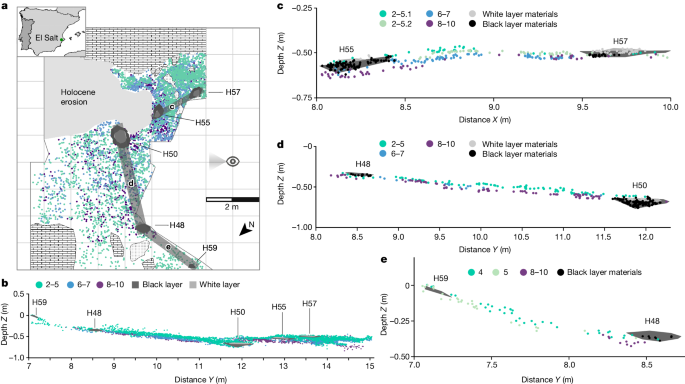Precise Timescale of Middle Palaeolithic Hearths Reveals Decade-to-Century Intervals of Human Occupation
Core Concepts
High-resolution archaeomagnetic and archaeostratigraphic analyses provide quantitative estimates of the time intervals between Middle Palaeolithic hearths, revealing human occupation events at the scale of human generations.
Abstract
The article addresses the challenge of resolving the timescale of human activity in the Palaeolithic Age, which is crucial for understanding social life and human-environment interactions. Conventional dating techniques and the impact of disturbances on sedimentary deposits have limited the ability to accurately reconstruct the time dimension of Palaeolithic contexts.
The researchers report on a study of six Middle Palaeolithic hearths from El Salt Unit x in Spain, using archaeomagnetic and archaeostratigraphic analyses to obtain high-resolution time differences between the hearths. The results show that the set of hearths covers at least around 200-240 years with 99% probability, with decade- and century-long intervals between the different hearths.
This provides a quantitative estimate of the time framework for the human occupation events included in the studied sequence, which is a significant advancement in Palaeolithic archaeology. Typically, human behavior in this discipline has been approached from a temporal scale typical of geological processes, whereas the new findings reveal that significant change may happen at the smaller scales of human generations.
The time between Palaeolithic hearths - Nature
Stats
The set of hearths covers at least around 200-240 years with 99% probability.
The different hearths are separated by decade- and century-long intervals.
Quotes
"Resolving the timescale of human activity in the Palaeolithic Age is one of the most challenging problems in prehistoric archaeology."
"Our results provide a quantitative estimate of the time framework for the human occupation events included in the studied sequence."
"This is a step forward in Palaeolithic archaeology, a discipline in which human behaviour is usually approached from a temporal scale typical of geological processes, whereas significant change may happen at the smaller scales of human generations."
Key Insights Distilled From
by Ánge... at www.nature.com 06-05-2024
https://www.nature.com/articles/s41586-024-07467-0
Deeper Inquiries
How can the high-resolution temporal data on Palaeolithic hearths be used to infer patterns of human social organization and mobility?
The high-resolution temporal data on Palaeolithic hearths can provide valuable insights into the patterns of human social organization and mobility during that time. By analyzing the duration and frequency of hunter-gatherer camps as reflected in the hearths, researchers can infer how long these camps were occupied and how often they were revisited. This information can shed light on the mobility patterns of ancient human groups, indicating whether they were nomadic or semi-sedentary. Additionally, the spacing between hearths can reveal the extent of social organization within these groups, showing whether different hearths were used by distinct social units or if there was a more communal sharing of spaces. Overall, the temporal data from Palaeolithic hearths can help reconstruct the social dynamics and mobility strategies of ancient human populations.
What limitations or potential biases might be present in the archaeomagnetic and archaeostratigraphic dating methods used in this study?
While archaeomagnetic and archaeostratigraphic dating methods provide valuable high-resolution temporal data, they are not without limitations and potential biases. One limitation is the reliance on environmental conditions for accurate readings, as factors like soil composition and geomagnetic fluctuations can affect the precision of the dating. Additionally, the presence of disturbances in the sedimentary deposits, such as bioturbation or post-depositional processes, can introduce biases into the dating results. Furthermore, the interpretation of archaeomagnetic data requires careful consideration of local geomagnetic variations, which can vary significantly over small geographic areas. These limitations and biases highlight the importance of cross-referencing multiple dating methods and conducting thorough validation processes to ensure the accuracy of the temporal data obtained.
What insights could be gained by applying similar high-resolution temporal analyses to Palaeolithic sites in other geographic regions or cultural contexts?
Applying similar high-resolution temporal analyses to Palaeolithic sites in other geographic regions or cultural contexts can provide a comparative perspective on human behavior and social dynamics during the Palaeolithic Age. By examining the temporal patterns of hearths and occupation events in different regions, researchers can identify similarities or differences in social organization, mobility strategies, and settlement patterns among ancient human populations. This comparative approach can help elucidate universal aspects of human behavior during the Palaeolithic period, as well as region-specific variations influenced by environmental factors, resource availability, or cultural practices. Furthermore, conducting temporal analyses in diverse geographic regions can contribute to a more comprehensive understanding of the temporal scales at which significant changes occurred in human societies during the Palaeolithic era.
0
